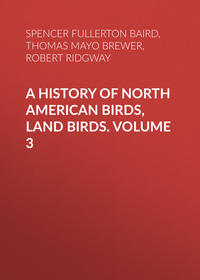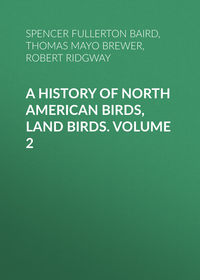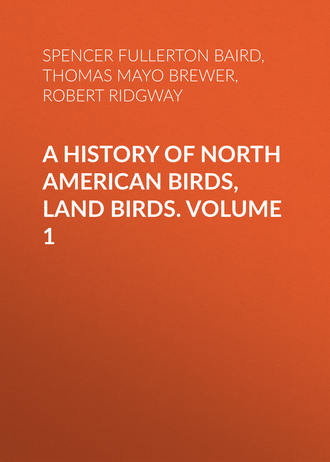 полная версия
полная версияA History of North American Birds, Land Birds. Volume 1
Hab. Entire North America, and in winter into South America as far as Ecuador, Cayenne, and Trinidad. Not recorded from West Indies, where replaced by allied species.
In the great abundance of this species and its wide range of distribution, there are many variations in size and color, though none that are not readily understood. In young birds the yellow of the tail-feathers is more restricted, sometimes confined to the edge of the inner webs. In adults there is occasionally a tinge of orange in the forehead.
Sylvia rathbonia of Audubon is described with even tail, and the tail-feathers brown, edged externally with yellow; the reverse of æstiva. It is generally, however, considered a synonyme.
Birds of this type (“Golden Warblers”) of six or eight additional species are known to occur in the West Indies, the Galapagos, and in Middle America; one of them, D. bryanti, possibly to be met with in Southern Arizona. (See Baird, Review Am. Birds, 193.)
After comparing a series of about one hundred and twenty North and Central American specimens (the latter being winter visitors to the region where obtained), nothing really characteristic of any particular region can be detected. Specimens from the Pacific coast of the United States are perfectly identical in colors with those from the Atlantic States; and they agree in size and proportions, except of the bill, which is appreciably longer and broader in the Eastern than in the Western birds. The most highly colored examples are from the interior regions, along the Mississippi Valley from Louisiana to Northern Illinois, and over the plains north to Fort Simpson. The majority of the specimens from this region are just appreciably different from others, in having the yellow more intense and prevalent, almost subduing the olive shades above; the crown more tinged with orange. Sometimes (as in No. 4,301, Calcasieu Pass, La.) the rump and upper tail-coverts are absolutely pure yellow, only a medial stripe on the feathers being olivaceous like the back. The orange-rufous tinge on the crown is deepest in Nos. 4,665, Fort Lookout, and 4,300, Calcasieu Pass.
Three adult summer males from Alaska (Nos. 54,429, Kodiak; 54,425, Yukon River; and 27,267, Fort Yukon), as well as one from Maine (52,378, Calais), differ from others in having the olive pervading the whole surface above, even to the bill, the forehead being only tinged with yellow, and the edges of wing-coverts merely inclining to this color. The lower parts are much as in Southern specimens, though the yellow is less intense.
Females from Arizona (as 49,712, Camp Grant, May; 40,664, Fort Whipple, May; and 34,340, Los Pinos, New Mexico, June) differ from others in very bleached plumage, the lower parts being almost white, and the upper surface quite ashy. But this is, in fact, an actual bleaching, frequently to be seen in birds from that region.
Habits. The geographical range of the common Summer Yellow-Bird is very nearly coextensive with North America. In its northern distribution it is found as far toward the arctic shores as any of our land birds. Richardson speaks of it as well known throughout the fur countries as far as the woods extend, and mentions meeting with it among the earliest arrivals in spring, coming in company with the equally well-known Robin and the Grakle. At Fort Franklin, latitude 66°, he saw it the 15th of May, about the time of its first appearance in New England. This was supposed to be the limit of its northern range, but more recent observations give abundant evidence of its presence, in considerable numbers, to the very shores of the Arctic Ocean. The late Mr. Hepburn, in manuscript notes, states it to be a common summer visitant both of California and Vancouver’s Island, and that along the coast he has traced it as far north as the frontier line of 54° 40′, where it arrives at the beginning of May, but does not nest until the end of the month.
Mr. Dall, in his notes on the birds of Alaska, states that this Warbler is a rather common bird all through that territory, and gives its arrival as about the 10th of May.
Its extreme southern limit is not so distinctly traced, but is at least as far as the northern portions of South America, inclusive of Cayenne and Ecuador. In all of the West Indies except Trinidad it is replaced by several closely allied species or local races. In Trinidad, Mr. E. C. Taylor states that he found this species common, and could perceive no difference from North American specimens. In Guatemala it is abundant in the winter.
Dr. Coues found this Warbler abundant in Arizona, where it is a summer resident, from April 25 to the middle of September. There, as elsewhere, its preference for watercourses was noticed. Wherever found, it is always most abundant in alluvial meadows, and more rare in other localities.
Dr. Samuel Cabot found this Warbler common in Central America, and Dr. Cragin, of Surinam, sent the Boston Society several specimens from Guiana. Dr. Woodhouse found it abundant in Texas and New Mexico, as did Drs. Suckley and Cooper in Washington Territory and California. It breeds over the whole area of North America, from Georgia on the southeast and from Mexico, northward. Dr. Sumichrast found it, only as a migratory bird, abundant on the plains of Mexico.
The notes of Mr. Kennicott and the memoranda of Messrs. McFarlane, Ross, and Lockhart attest the extreme abundance of this species in the farthest Arctic regions. In nearly every instance the nests were placed in willows from two to five feet from the ground, and near water. In one instance Mr. Ross found the eggs of this species in the nest of Turdus swainsoni, which had either been deserted or the parent killed, as the eggs were in it, and would probably have been hatched by the Warbler with her own.
Dr. Cooper found this Warbler very abundant in Washington Territory, and noticed their arrival in large numbers at the Straits of Fuca as early as April 8.
The Summer Yellow-Bird arrives in New England with great uniformity from the first to the middle of May. Its coming is usually the harbinger of the opening summer and expanding leaves. Unlike most of its family, it is confiding and familiar, easily encouraged, by attention to its wants, to cultivate the society of man. It confidingly builds its nest in gardens, often in close vicinity to dwellings, and in the midst of large villages and cities, among the shrubbery of frequented parks. This Warbler, soon after its arrival, begins the construction of its nest. It is usually placed in low bushes, three or four feet from the ground. Occasionally very different positions are chosen. Hedges of buckthorn and hawthorn, barberry-bushes, and other low shrubs, are their favorite places of resort. On one occasion the nest was placed some forty feet from the ground, in the top of a horse-chestnut tree overhanging the main street of a village. Such high positions are, however, not very common.
The nest is invariably fastened to several twigs with great firmness, and with a remarkable neatness and skill. A great variety of materials is employed in the construction of their nests, though not often in the same nest, which is usually quite homogeneous. The more common materials are the hempen fibres of plants, fibrous strips of bark, slender stems of plants and leaves, and down of asclepias. Interwoven with these, forming the inner materials, are the down from willow catkins, the woolly furze from fern-stalks and the Eriophorum virginicum, and similar substances. These are lined with soft, fine grasses, hair, feathers, and other warm materials. Cotton, where procurable, is a favorite material; as also is wool, where abundant. I have known instances where nests were built almost exclusively of one or the other material. A pair of these birds, in 1836, built their nest under a parlor window in Roxbury, where all their operations could be closely watched. When discovered, only the framework, the fastening to the supporting twigs, had been erected. The work of completion was simple and rapid. The female was the chief builder, taking her position in the centre of the nest and arranging the materials in their places as her mate brought them to her. Occasionally, with outstretched wings and expanded tail, she would whirl herself round, giving to the soft and yielding materials their hemispherical form. At intervals she arrested her revolutions to stop and regulate with her bill some unyielding portion. When her mate was dilatory, she made brief excursions and collected material for herself, and when the materials brought her were deemed unsuitable, they were rejected in a most summary and amusing manner. The important part of the tail-feathers in shaping the nest and placing the materials in position was a striking feature in this interesting performance. The greater portion of the nest was thus constructed in a single day.
The wonderful sagacity displayed by this Warbler in avoiding the disagreeable alternative of either having to abandon its own nest or of rearing the young of the intrusive Cow Blackbird, when one of these eggs is dropped in her nest, was first noticed by Mr. Nuttall. The egg of the parasite, being too large for ejectment, is ingeniously incarcerated in the bottom of the nest, and a new lining built over it. Occasionally, either by accident or design, the intrusive egg has been fractured. Mr. Nuttall states that where the parasitic egg is laid after her own, the Summer Yellow-Bird acts faithfully the part of a foster-parent. This, however, is not according to my observations. In several instances I have known the Summer Yellow-Bird utterly refuse to act the part of a foster-parent, and, rather than do so, sacrifice her own eggs. So far as I know, this Warbler will never sit upon or hatch out the egg of the Cowbird, under any circumstances. Some powerful instinct, bordering closely upon reason, seems to teach these intelligent Warblers the character of the intruder, and they sacrifice their own eggs rather than rear the parasite. In this dilemma they will always, so far as I know, incarcerate their own eggs with the Cowbird’s and reconstruct the nest above them. In one instance the same pair of Yellow-Birds twice, in the same nest, covered up alien eggs in this manner, building, in fact, three nests one above the other, between the walls of which had been successively included two eggs of the Cowbird. This three-storied nest measured seven inches in length, and was built almost exclusively of raw cotton. The covering of the imprisoned eggs was about two thirds of an inch thick. In both instances the Cowbird’s eggs had been broken, apparently by design.
So far as I am aware this Warbler raises but one brood in Massachusetts in a season. In Pennsylvania it is said to raise two, and even three. The eggs are usually five and occasionally six in number.
This Warbler is conspicuous in its devotion to its young, evincing a strong attachment and an anxiety in regard even to an unoccupied nest, and betraying the site by this solicitude. They will also resort to various expedients to draw one away from their nest, by feigned lameness and other stratagems and manœuvres.
The song of the Summer Yellow-Bird is simple but pleasing, and is easily recognized when once known, though liable to be confounded with that of the Maryland Yellow-Throat, and also said to resemble the song of several other Warblers.
In confinement they usually become very tame, confiding, and reconciled to their imprisonment, and have been known to perch on an outstretched finger, and to catch flies in a room.
Their eggs vary in length from .61 to .70 of an inch, and in breadth from .49 to .52. They have a ground-color of a light green. Their dots and blotches vary greatly in number, size, and manner of distribution. Their colors are light purple, darker purplish-brown, and other shades of brown and lilac.
Dendroica coronata, GrayYELLOW-RUMP WARBLER; MYRTLE WARBLERMotacilla coronata, Linn. Syst. Nat. I, 1766, 333. Sylvia coronata, Lath.; Vieillot; Wils.; Nutt.; Aud. Orn. Biog. II, pl. cliii. Sylvicola coronata, Swains.; Bon.; Aud. Birds, Am. II, pl. lxxvi.—Jones, Nat. Bermuda, 59 (abundant in April). Dendroica coronata, Gray, Genera, 1842, 2.—Baird, Birds N. Am. 1858, 272; Rev. 187.—March, P. A. N. Sc. 1863, 292 (Jamaica, in summer; breeding).—Gundl. Cab. Jour. 1861, 326 (Cuba; common).—Cooper & Suckley, P. R. R. XII, II, 1859, 180 (Puget Sound).—Samuels, 226.—Dall & Bannister (Alaska).—Cooper, Orn. Cal. 1, 1870, 89. Rhimanphus cor. Cab. Jour. 1855, 473 (Cuba). Motacilla canadensis, Linn. 12th ed. 1766, 334 (Ficedula canadensis cinerea, Br. III, 524, pl xxvii, fig. 1). Parus virginianus, Linn. 12th ed. Syst. Nat. I, 1766, 342. Motacilla umbria, cincta, pinguis, Gm. Sylvia xanthopygia, Vieill. Sylvia xanthoroa, Vieill.
Localities quoted: S. Greenland, Reinhardt, Ibis, 1861, 5. Cordova, Scl. P. Z. S. 1856, 291. Xalapa, Ib. 1859, 363. Guatemala, Scl. & Salv. 1859, 11. Panama, Lawr. Ann. N. Y. Lyc. VIII, 63. Cuba, winter, Cab. Jour. III, 473. Bahamas, winter, Bryant, Bost. Pr. VII, 1859. Jamaica, Gosse, Birds Jam. 155. St. Domingo, Sallé, P. Z. S. 1857, 231. Costa Rica, Lawr. Orizaba, winter, Sumichrast.
Sp. Char. Above bluish-ash, streaked with black. Under parts white. The forepart of breast and the sides black, the feathers mostly edged narrowly with white. Crown, rump, and sides of breast yellow. Cheeks and lores black. The eyelids and a superciliary stripe, two bands on the wing and spots on the outer three tail-feathers, white. Female of duller plumage and browner above. Length, 5.65; wing, 3.00; tail, 2.50.
Hab. Eastern Province of North America, and northward, extending sparsely along United States boundary to Pacific Ocean; Denver City, Colorado; Fort Yukon; Greenland; Eastern Mexico to Panama R. R.; Western West Indies and Bermuda. Breeds in Jamaica!
Autumnal and winter birds are very much duller and more obscurely colored, the upper parts of an umber cast with the streaks almost obsolete; the black of the breast wanting or but just indicated, and the yellow patches on crown almost concealed by the brown tips to the feathers, and those on side of breast quite dull.
A spring male (52,283) from Washington is remarkable in having the adjoining series of feathers down the middle of the back with their inner webs broadly edged with yellow. In this respect it differs from all others that we have noticed.
Habits. The Yellow-crowned Wood Warbler is one of the most common species of this genus, as well as one of the most widely distributed. It is found, at different seasons, throughout the eastern part of the continent, as far west as the Great Plains, extending at the far north to the Pacific Ocean. It has been found in Greenland, three specimens having been taken within twenty years, and on the shores of the Arctic Ocean, and during the winter in the West India Islands, Mexico, and Central America. Specimens from Florida and Fort Steilacoom, Panama, Guatemala, and Jamaica, and from Fort Rae, Anderson River, and the Yukon, in the collection of the Smithsonian Institution, attest its wide distribution. In Jamaica, in the neighborhood of Spanishtown, this species has been known to breed. In view of the fact that this bird is regarded, with good reason, as one of our most northern species, breeding to the very shores of the frozen seas, the occurrence seems erratic and remarkable. Yet it is not without corresponding vagaries in other species, the cærulescens breeding in Cuba and the tigrina in St. Domingo and Jamaica.
Mr. Paine, of East Randolph, Vt., states that these Warblers arrive in his vicinity about the first of May, and remain there nearly two weeks, and then all pass north. They do not return on their southern flight until the last of September, when they remain about three weeks. It is a very active, restless bird, chirping continually and very sharply as it flies around in search of insects, but has not, so far as he knows, any song.
In Southern Illinois, as Mr. Ridgway informs me, this bird is a common winter sojourner, remaining late in spring with the migratory species. It is very abundant throughout the winter in woods, orchards, and door-yards.
Mr. Salvin found this species frequenting the more open districts about Duenas, Guatemala, apparently preferring scattered bushes to the denser underwood, and was an abundant species there throughout the winter season.
It is but quite recently that we have known with certainty its place and manner of breeding. Neither Wilson, Nuttall, nor Audubon appear to have met with its nest, though the latter received one from Professor McCulloch of Halifax.
In the summer of 1855, early in July, I obtained a nest of this species in Parsboro’, Nova Scotia. It was built in a low bush, in the midst of a small village, and contained six eggs. The parents were very shy, and it was with great difficulty that one of them was secured for identification. Though late in the season, incubation had but just commenced.
The nest was built on a horizontal branch, the smaller twigs of which were so interlaced as to admit of its being built upon them, though their extremities were interwoven into its rim. The nest was small for the bird, being only two inches in depth and four and a half in diameter. The cavity is one and a half inches deep and two and a half wide. Its base and external portions consist of fine, light, dry stalks of wild grasses, and slender twigs and roots. Of the last the firm, strong rim of the nest is exclusively woven. Within, the nest is composed of soft, fine grasses, downy feathers, and the fine hair of the smaller mammals.
Mr. Audubon, who observed very closely the habits of these birds during a winter in Florida, describes them as very social among themselves, skipping along the piazza, balancing themselves in the air opposite the sides of the house in search of spiders and insects, diving through the low bushes of the garden after larvæ and worms, and at night roosting among the orange-trees. In his visit to Maine he found them very abundant in early May. The woods seemed alive with them, and wherever he landed, on his way to Labrador, he found them in great numbers.
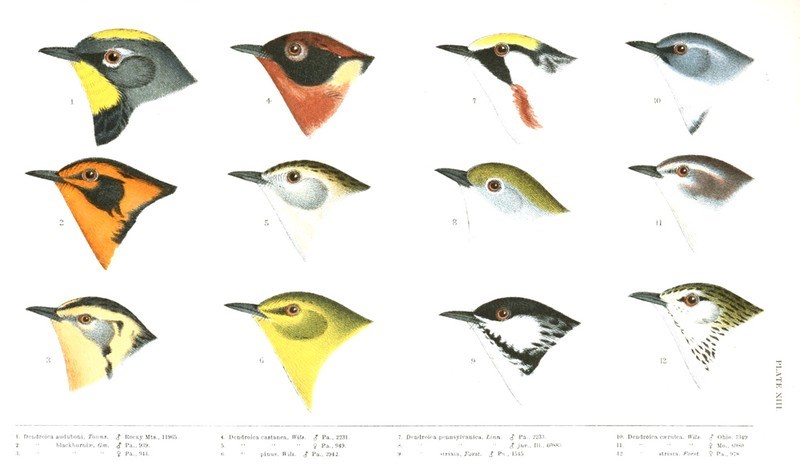
PLATE XIII.
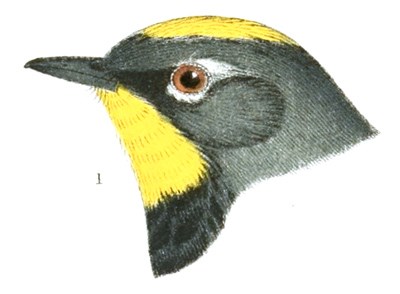
1. Dendroica auduboni, Towns. ♂ Rocky Mts., 11965.
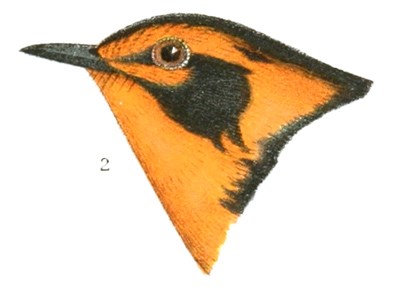
2. Dendroica blackburniæ, Gm. ♂ Pa., 939.
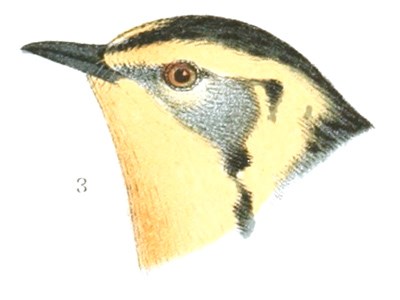
3. Dendroica blackburniæ, Gm. ♀ Pa., 944.
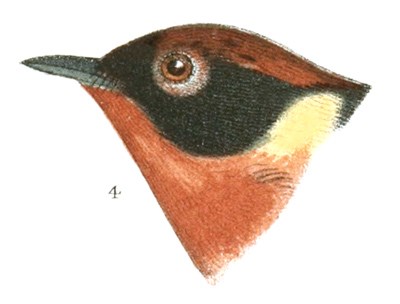
4. Dendroica castanea, Wils. ♂ Pa., 2231.

5. Dendroica castanea, Wils. ♀ Pa., 949.
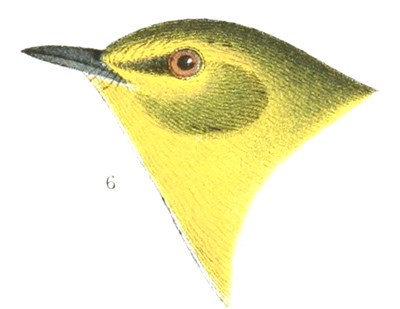
6. Dendroica pinus, Wils. ♂ Pa., 2942.

7. Dendroica pennsylvanica, Linn. ♂ Pa., 2233.
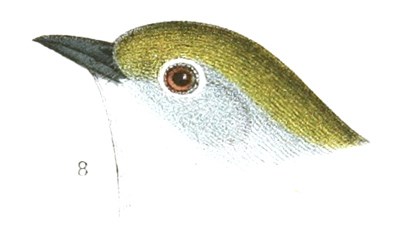
8. Dendroica pennsylvanica, Linn. ♂ juv., Ill., 60883.

9. Dendroica striata, Forst. ♂ Pa., 1545.

10. Dendroica cærulea, Wils. ♂ Ohio, 7349.
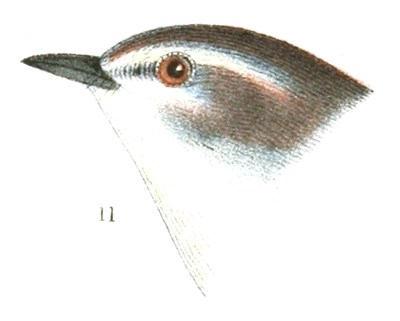
11. Dendroica cærulea, Wils. ♀ Mo., 6980.

12. Dendroica striata, Forst. ♀ Pa., 978.
This Warbler is an expert flycatcher, feeds chiefly on insects, and is a great devourer of small caterpillars; but in the winter its food is largely composed of berries, especially those of the Myrica cerifera. It will also feed on grass-seeds. In the warmer wintry days in Florida, when insects are abundant, Mr. Audubon states that these birds are particularly active in their pursuit, and the trees seem full of them. At this time they emit, at each movement, a single note, twēēt, so very peculiar that they may be at once recognized by the cry.
Wilson states that these Warblers appear in Pennsylvania, from the North, early in October, and stay there several weeks. Some of them remain in the Southern States all winter. They feed with great avidity upon the berries of the red cedar.
In Western Massachusetts it is a very abundant spring and autumn visitant, making but a brief stay in spring, but passing northward in large numbers. In autumn it remains longer, and passes south more leisurely. Mr. B. P. Mann found its nest and eggs in Concord, but this was probably an exceptional instance. In Eastern Maine it arrives May 25, and, as Mr. Boardman thinks, remains to breed. Both Dr. Suckley and Dr. Cooper met with this species in Washington Territory, where it is very rare.
No writers have observed or noted the song of this bird, except Mr. T. M. Trippe (American Nat., II. p. 171), who states that during its spring migrations it has a very sweet song or warble, uttered at short intervals.
It reaches the high northern latitudes late in May, and leaves that region in September. The observations of Mr. McFarlane show that the nests of this bird are moderately common at Anderson River, and are generally built in low spruce-trees four or five feet from the ground. In one or two instances it was placed on the ground.
The eggs of this Warbler vary from .72 to .80 of an inch in length, and from .50 to .55 in breadth. Their ground-color is white, often tinged with a bluish shade, and blotched and spotted with reddish-brown, purple, and darker shades of brown. They are of a rounded oval shape.
Dendroica auduboni, BairdAUDUBON’S WARBLER; WESTERN YELLOW-RUMPSylvia auduboni, Townsend, J. A. N. Sc. VII, II, 1837.—Ib. Narrative, 1839, 342.—Aud. Orn. Biog. V, 1839, 52, pl. cccxcv. Sylvicola auduboni, Bon. List. 1838.—Aud. Birds Am. II, 1841, 26, pl. lxxvii. Dendroica auduboni, Baird, Birds N. Am. 1858, 273; Rev. 188.—Sclater, P. Z. S. 1858, 298 (Oaxaca; October); 1860, 250 (Orizaba).—Sclater & Salvin, Ibis, 1860, 273 (San Geronimo, Guat.).—Cooper & Suckley, P. R. R. Rep. XII, II, 1859, 181.—Sclater, P. Z. S. 1864, 172 (City of Mexico).—Cooper, Orn. Cal. 1, 1870, 88.
Sp. Char. Above bluish-ash, streaked with black, most marked on the middle of the back; on the head and neck bluish-ash. Middle of crown, rump, chin, and throat, and a patch on the side of the breast, gamboge-yellow; space beneath and anterior to the eyes, forepart of breast and sides, black; this color extending behind on the sides in streaks. Middle of belly, under tail-coverts, a portion of upper and lower eyelids, and a broad band on the wings, with a spot on each of the four or five exterior tail-feathers, white; rest of tail-feathers black. Female brown above; the other markings less conspicuous and less black. Length, 5.25; wings, 3.20; tail, 2.25. Young, first plumage, whole body, including head all round and rump, conspicuously streaked with slaty-black upon an ashy ground above and white below. No yellow on crown, rump, breast, or throat. Wings and tail as in autumnal adult.
Hab. Western and Middle Provinces of the United States; Cape St. Lucas; Western Mexico and Orizaba? Oaxaca (cold regions, October, Sclater); Guatemala (Salvin).
This bird is very closely allied to D. coronata, but is distinguished by the yellow (not white) throat; the absence of a superciliary white stripe (the eyelids white, however); the restriction of the black of the face to the lores, and to a suffusion round the eye; and the presence of one broad band on the wings, instead of two narrow ones.




